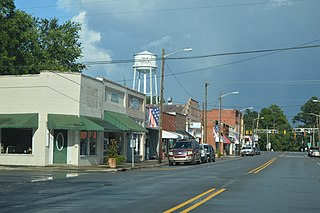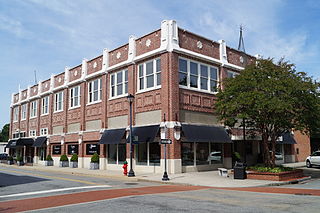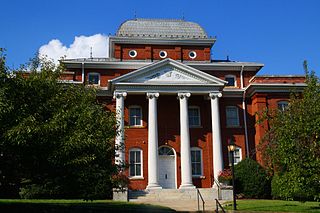
Faison Historic District is a national historic district located at Faison, Duplin County, North Carolina. The district encompasses 116 contributing buildings, 2 contributing structures, and 1 contributing object in the central business district and surrounding residential area of Faison. It includes industrial, residential, and commercial buildings with notable examples of Greek Revival, Queen Anne, and Italianate style architecture. Notable buildings include the Cates Pickle Company (1931), Moore Lee Thornton Store, C. S. Hines Store, Clifton's Service Station (1933), The Walter Livingston Hicks House, Faison Pharmacy, Witherington Building (1915), Faison Depot (1888), Presbyterian Church (1918), Elias Faison House, Faison-Williams House (1853), and Witherington House (1880).

Downtown Gastonia Historic District is a national historic district located at Gastonia, Gaston County, North Carolina. It encompasses 77 contributing buildings and 1 contributing object in the central business district of Gastonia. The commercial, civic, institutional, and multi-unit residential buildings were built between the 1890s and 1954, and include notable examples of Colonial Revival and Classical Revival architecture. Located in the district are the separately listed former Gaston County Courthouse, First National Bank Building, Third National Bank Building, and Robinson-Gardner Building. Other notable buildings include the U.S. Post Office (1935), York Medical Building (1938), Kress Department Store, Leibowitz Department Store, Ideal Moving Picture Theater, City Hall, Kirby Building (1922), First Baptist Church (1922), Gaston County War Memorial Hall (1928), and the (former) Gaston County Public Library (1930).

The Bessemer City Downtown Historic District is a national historic district in Bessemer City, Gaston County, North Carolina. It encompasses 23 contributing buildings and 10 contributing structures in Bessemer City's central business district. The buildings were built between after 1896, and include one- and two-story commercial buildings and two large, sprawling textile mill complexes. Notable buildings include:

Downtown Greensboro Historic District is a national historic district located at Greensboro, Guilford County, North Carolina. When first listed, the district encompassed 96 contributing buildings in the central business district of Greensboro. The commercial buildings were built between about 1885 and the 1930s in a variety of popular architectural styles including Italianate and Art Deco. Located in the district is the separately listed Jefferson Standard Building. Other notable buildings include the Vanstory Building, Kress Building (1929), Woolworth's, Efrid's Department Store, Montgomery Ward (1936), the Carolina Theatre (1927), Center Theatre (1948), the former Belk Building (1939), Ellis Stone/Thalhimer's Department Store (1949-1950), and the former American Exchange National Bank Building (1920). The Woolworth's store is notable as the site of the Greensboro sit-ins of 1960.

Dunn Commercial Historic District is a national historic district located at Dunn, Harnett County, North Carolina. It encompasses 54 contributing buildings and one contributing structure in the central business district of Dunn. The predominantly commercial buildings were built between about 1900 and 1959, and includes notable examples of Italianate style architecture. Notable buildings include the Fitchett Drug Store, Cottondale Hotel (1924), Fleishman Brothers Company building, Prince's Department Store Building, Christo-Cola Bottling Works Building, White Way Theater Building, Johnson Cotton Company Building, and (former) Dunn Post Office (1937).

Four Oaks Commercial Historic District is a national historic district located at Four Oaks, Johnston County, North Carolina. It encompasses 29 contributing buildings and 1 contributing structure in the town of Four Oaks. It includes notable examples of Mission Revival style architecture and buildings dating from about 1890 to 1957. It includes commercial, residential, ecclesiastical, and educational structures. Notable buildings include the W.E. Stanley Store, Blake Adams Store (1904), Four Oaks Bank Building, Lassiter Building, W. D. Allen Building (1926), Four Oaks Drugstore (1937), Sinclair Gas Station.

Downtown Spruce Pine Historic District is a national historic district located at Spruce Pine, Mitchell County, North Carolina. The district encompasses 33 contributing buildings in the central business district of Spruce Pine. It was developed between 1909 and 1953, and includes notable examples of Early Commercial and Tudor Revival style architecture. Located in the district is the separately listed Gunter Building. Other notable buildings include the Spruce Pine Depot (1909), Crystal Place (1937), (former) Town Hall (1940), and Day's Drug Store (1950).

Jackson Historic District is a national historic district located at Jackson, Northampton County, North Carolina. The district encompasses 168 contributing buildings, 2 contributing sites, 1 contributing structure, and 2 contributing objects in the central business district and surrounding residential sections of Jackson. The district developed between about 1825 and 1953 and includes notable examples of Federal and Greek Revival style architecture. Located in the district are the separately listed Amis-Bragg House, Church of the Saviour and Cemetery, and Northampton County Courthouse Square. Other notable contributing resources include Lewis Drug Store (1930), Kennedy's Five Cents to Five Dollars Store, Bank of Northampton (1928), Bowers Hardware Store, Atlas Oil Company Building, Farmer's Cotton Gin Complex, Faison House, Saint Catherine's Hall (1848), Judge Robert Peebles House (1890s), Selden-Boone House, Jackson Baptist Church (1881), and Jackson United Methodist Church (1937).

Richlands Historic District is a national historic district located at Richlands, Onslow County, North Carolina. The district encompasses 90 contributing buildings, 2 contributing structures, and 2 contributing objects in the central business district and surrounding residential sections of Richlands. The district largely developed after 1880 and includes notable examples of Late Victorian and I-house style residential architecture. Notable contributing buildings include the Robert D. Thompson House (1908), Daniel Webster Murrill House (1908), the Del Barbee House (1910), the Edwards-Cox House (1915), Isaac Koonce House (1918), George Brooks House (1915), Franck House (1914), Richlands Theater (1936), J. F. Mohn Building (1936), Richlands Supply Company Building (1905), M. B. Steed Store (1911), Peoples Bank Building, Bank of Richlands (1927), First Baptist Church (1920s), and Richlands United Methodist Church (1939).

Hertford Historic District is a national historic district located at Hertford, Perquimans County, North Carolina. The district encompasses 219 contributing buildings, 2 contributing sites, 1 contributing structure, and 1 contributing object in the central business district and surrounding residential sections of Hertford. The district developed between about 1759 and 1948, and includes notable examples of Federal, Greek Revival, and Gothic Revival style architecture. Located in the district are the separately listed Perquimans County Courthouse and Church of the Holy Trinity. Other notable buildings include the Creecy-Skinner-Whedbee House, Edward Wood House, Matthews-Jacocks House, Temperance Hall (1851), Matthew H. White House, Dr. Thomas S. McMullan House (1905), Thomas Nixon House, William M. Divers House (1924), W.R. Shannonhouse Building (1895), Darden Department Store, Farmers National Bank of Hertford (1916), State Theatre (1937), Old Hertford Post Office (1915), Hertford Baptist Church (1854), and Hertford United Methodist Church (1901).

Greenville Commercial Historic District is a national historic district located at Greenville, Pitt County, North Carolina. The district encompasses 51 contributing buildings in the central business district of Greenville. It includes buildings dated from about 1914 to 1952 and notable examples of Greek Revival and Queen Anne style architecture. Located in the district and listed separately are the Pitt County Courthouse (1911) by Milburn, Heister & Company and U.S. Post Office (1913). Other notable buildings include the Proctor Hotel (1911), Montgomery Ward Department Store (1929), Dail-Hodges Building (1919), Blount Building (1924), Greenville Bank and Trust, Smith Electric Building, Greenville Municipal Building (1929) designed by Benton & Benton, Blount-Harvey Department Store (1923), White's Theater (1914), Charles Greene House (1860), and the Robert Lee Humber House (1895).

Main Street Commercial Historic District is a national historic district located at Hamlet, Richmond County, North Carolina. The district encompasses 23 contributing buildings, 3 contributing structures, and 1 contributing object in the central business district of Hamlet. It includes buildings built between about 1900 to about 1940 and notable examples of Queen Anne, Art Deco, and Classical Revival architecture. Located in the district is the separately listed Seaboard Air Line Passenger Depot. Other notable buildings include the Terminal Hotel, Union Building, the Bank of Hamlet (1912), the Old Hamlet Opera House, and the U.S. Post Office (1940), a Works Progress Administration project.

Lumberton Commercial Historic District is a national historic district located at Lumberton, Robeson County, North Carolina. The district encompasses 64 contributing buildings and 1 contributing site in the central business district of Lumberton. It includes buildings built between about 1840 to 1941 in a variety of popular architectural styles including Classical Revival and Streamline Moderne. Located in the district are the separately listed Carolina Theatre and Planters Building. Other notable buildings include the Proctor Law Office, McLeod Building (1879), (former) National Hotel, (former) Efird's Department Store, Huggins Star Shoe Shop, National Bank of Lumberton (1914), Dresden Cotton Mills Office Building, (former) Lumberton Municipal Building (1917), and Stephens Funeral Home (1936).

Leaksville Commercial Historic District is a national historic district located at Eden, Rockingham County, North Carolina. It encompasses 12 contributing buildings in the central business district of the town of Eden. It includes buildings dated between about 1885 and 1939, and notable examples of Greek Revival, Classical Revival, and Colonial Revival style architecture. Notable buildings include a house built about 1840, the Realty Building (1924-1925), Leaksville Mercantile Building, Carter-Moir Hardware/Smith-Lane Store, the Fagg-King Building, Mitchell's Drug Store (1936), DeHart Building (1938), and United States Post Office (1939) designed by architect Louis A. Simon and built as a Works Progress Administration project.

Danbury Historic District is a national historic district located at Danbury, Stokes County, North Carolina. The district encompasses 44 contributing buildings in the central business district and surrounding residential section of Danbury. They were built between about 1860 and 1930 and include notable examples of Queen Anne, Romanesque Revival, and Bungalow architecture. Located in the district and separately listed is the Stokes County Courthouse. Other notable buildings include the County Jail (1904), Petree Store, the Martin Store, Stack-Bickett Law office (1888), Bank of Stokes County, McCannless Hotel, James Pepper House, Wilson Fulton brick house, Samuel H. Taylor House/Hotel, the N. E. Wall House, Baptist Mission Church, Clark Memorial Presbyterian Church, and the Methodist Church.

Downtown Elkin Historic District is a national historic district located at Elkin, Surry County, North Carolina. The district encompasses 51 contributing buildings and 2 contributing structures in the central business district of Elkin. They were primarily built between about 1890 and 1950 and include notable examples of Early Commercial and Bungalow / American Craftsman architecture. Notable buildings and structures include the Gwyn-Foard House, Hugh G. Chatham Bridge (1931), Liberty Tobacco Warehouse, Harris Building (1902), U.S. Post Office (1937) designed by the Office of the Supervising Architect under Louis A. Simon, former Elkin Town Hall (1938–1939) built by the Works Progress Administration, Dobbin's Store, and the Riverside Hotel (1915–1925).

Mount Airy Historic District is a national historic district located at Mount Airy, Surry County, North Carolina. The district encompasses 187 contributing buildings in the central business district and surrounding industrial and residential sections of Mount Airy. They were primarily built between about 1880 and 1930 and include notable examples of Late Victorian and Bungalow / American Craftsman architecture. Located in the district are the separately listed W. F. Carter House and Trinity Episcopal Church. Other notable buildings include the Abram Haywood Merritt House (1902), William A. Estes House, Thomas Fawcett House, J. D. Sargent House (1919), Campbell A. Baird House (1913), T. Benton Ashby House, First Baptist Church (1906-1912), Mount Airy Friends (1904), Presbyterian Church (1907-1914), Merritt Building, Banner Building (1906), Prather Block, Midkiff Hardware Store, Welch Block, West Drug Store, Belk's Building, (former) Workman's Federal Savings and Loan, (former) First National Bank (1893), Bank of Mount Airy (1923), U.S. Post Office (1932-1933), and the Sparger Brothers Tobacco Factory.

The Waxhaw Historic District is a national historic district located at Waxhaw, Union County, North Carolina. It encompasses 93 contributing buildings, 3 contributing structures, and 1 contributing object in the central business district and surrounding residential sections of Waxhaw. The district developed between about 1888 and 1940 and includes notable examples of Commercial Style, Queen Anne, and Bungalow / American Craftsman style architecture. Notable buildings include the former Post Office (1905), Harris's store, Tyson Store, A.W. Heath Co. Mill (1905), R.J. Belk Company Store, A.W. Heath Company Stores, Weir Building, Plyler Building, Farmer's Ginning & Trading Company, McDonald Hotel (1912), Waxhaw Presbyterian Church (1929), Duncan McDonald House, and Ralph J. Belk House.
Wake Forest Historic District is a national historic district located at Wake Forest, Wake County, North Carolina. The district encompasses 245 contributing buildings, one contributing site, and five contributing structures built between about 1890 and 1953 and located in the historic core of the town of Wake Forest. It includes notable examples of Greek Revival and Federal style architecture. Located in the district are the separately listed Lea Laboratory, South Brick House, and the Powell-White House, a contributing resource in the Glen Royall Mill Village Historic District. Other notable buildings include the historic campus of Wake Forest College, Wake Forest Baptist Church (1913), Magnolia Hill (1928), Calvin Jones House, John M. Brewer House, Wait-Taylor House (1843), Taylor-Purefoy-Poteat-Swett House, Community House, St. Catherine of Siena Catholic Church, the Powers Store (1897), and former Water and Light Building (1909).

Plymouth Historic District is a national historic district located in Plymouth, Washington County, North Carolina. The district encompasses 258 contributing buildings, 5 contributing sites, and 1 contributing structure in the central business district and surrounding residential sections of Plymouth. It was largely developed between about 1880 and 1930 and includes notable examples of Colonial Revival, Bungalow / American Craftsman and Late Victorian style architecture. Located in the district are the separately listed Latham House, Perry-Spruill House, and Washington County Courthouse. Other notable buildings include the Hornthal-Owens Building, Blount Building, Atlantic Coast Line Railroad Station (1923), Davenport-Davis House, Robert Ward Johnston House (1924), Latham-Brinkley House (1883), Plymouth United Methodist Church and Cemetery, Grace Episcopal Church and Cemetery designed by Richard Upjohn, New Chapel Baptist Church (1924), Agricultural Building (1936-1937) constructed through the Works Progress Administration, Plvmouth Railroad Station (1927), Brinkley Commercial Block (1926), and Clark-Chesson House.























